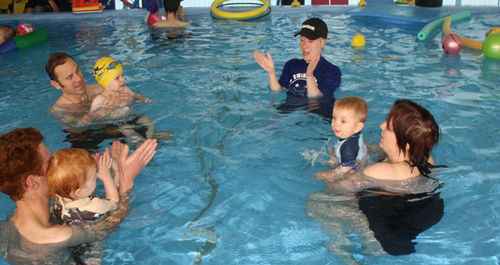I have been teaching for 30 yrs. I come from a swimming background, have been involved in the sport and involved in national swimming education organisations. My swim school, JC Swim employs 30 staff. We teach school and after school classes from babies (6 months old) through to adults.
I always feel it is valuable information for parents who are thinking of participating in a swim class to know answers to the most frequently asked questions, so here are a few:
 1. Why does it take ages for children to acquire the freestyle stroke? Why can’t kids swim in a couple of terms?
1. Why does it take ages for children to acquire the freestyle stroke? Why can’t kids swim in a couple of terms?
Let’s compare learning to swim and learning to walk. The practice time it takes to master the complex skill of learning to walk, usually happens between the age of 10 to 16 months; and generally over a four month period. The path to success involves gaining the strength and confidence to ‘pull up’, taking first steps, then on to walking about with hands in the air to assist balance. This is an exciting phase of development for babies as they are gaining muscle strength, coordination and vestibular development for balance. This trial and error process with 12 hours a day role modelling from parents and siblings (walking about around them) might be practiced conservatively 2 hours each day over 120 days totalling 240 hours of practice. Learning to swim is a similar process with similar levels of complexity. The only difference is the practise time and the ability to practise in an environment that has less risk of injury.
2. How can parents assist in this process?
Participate in quality classes. Classes that have visible goals and outcomes
Go to the pool as a family and play/enjoy the aquatic environment. Children are always learning. An aquatic environment challenges your child through walking, jumping and splashing.
Encourage your child to participate in core strength activities e.g. rope climbing, ball games, skating, martial arts, gymnastics and ballet.
Encourage your child to participate in fitness activities e.g. swimming, brisk walking, cycling, skiing, soccer, rugby, netball and athletics.
A mix will provide very good outcomes in all activities Exercise builds muscle, helps prevent chronic illness, keeps us lean and strengthens us emotionally and physically. It also boosts brain power. Swimming skills are learned best through quality practice and positive feedback in a fun supportive environment.
3. What gives children the best chances of survival in a “dangerous water” scenario?
To have a greater chance of survival in the water children must be able to back float, have breath control, propulsion, rotation and distance stamina. Participating in a programme based on physical development, fitness and good planning will produce outcomes.
When I teach and when I train instructors, the aim is to provide swimmers of all levels, with skills that will give them a greater chance of survival in a water emergency situation. But it’s also important to make it all fun, especially with children, and to connect with them so that they can enjoy their water experience. Babies naturally feel at home in the water, as the video clip below shows. If those learning to swim can connect with our natural enjoyment of being in the water, then progress at their own pace, things will go well. Come swim with me!
Related Links:
http://www.jcswimschool.co.nz/
http://www.odt.co.nz/sport/swimming/303425/swimming-three-awards-swim-school

